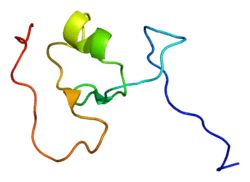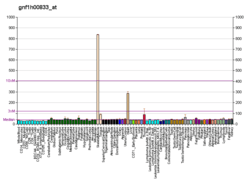TRIM63
E3 ubiquitin-protein ligase TRIM63 is an enzyme that in humans is encoded by the TRIM63 gene.[5][6][7]
This gene encodes a member of the RING zinc finger protein family found in striated muscle and iris. The product of this gene is localized to the Z-line and M-line lattices of myofibrils, where titin's N-terminal and C-terminal regions respectively bind to the sarcomere. In vitro binding studies have shown that this protein also binds directly to titin near the region of titin containing kinase activity. Another member of this protein family binds to microtubules. Since these family members can form heterodimers, this suggests that these proteins may serve as a link between titin kinase and microtubule-dependent signal pathways in muscle.[7]
The protein encoded by the Trim63 gene is also called MuRF1. MuRF1 is the name most commonly used in the literature, and it stands for "Muscle RING Finger 1." Structurally, there are two closely related MuRFs, MuRF2 and MuRF3. These also have TRIM codes: MuRF2 is TRIM55; MuRF3 is TRIM54.
Interactions
Trim63/MuRF1 has been shown to be an E3 ubiquitin ligase. Its major substrate is Myosin Heavy Chain. MuRF1 is upregulated during skeletal muscle atrophy – and thus the degradation of myosin heavy chain, which is a major component of the sarcomere, is an important mechanism in the breakdown of skeletal muscle under atrophy conditions. MuRF1 has been shown to be upregulated during denervation, administration of glucocorticoids, immobilization, and casting. All of these treatments cause skeletal muscle atrophy.
TRIM63 has been shown to interact with Titin,[5] GMEB1[8] and SUMO2.[6]
References
- GRCh38: Ensembl release 89: ENSG00000158022 - Ensembl, May 2017
- GRCm38: Ensembl release 89: ENSMUSG00000028834 - Ensembl, May 2017
- "Human PubMed Reference:". National Center for Biotechnology Information, U.S. National Library of Medicine.
- "Mouse PubMed Reference:". National Center for Biotechnology Information, U.S. National Library of Medicine.
- Centner T, Yano J, Kimura E, McElhinny AS, Pelin K, Witt CC, Bang ML, Trombitas K, Granzier H, Gregorio CC, Sorimachi H, Labeit S (Mar 2001). "Identification of muscle specific ring finger proteins as potential regulators of the titin kinase domain". J Mol Biol. 306 (4): 717–26. doi:10.1006/jmbi.2001.4448. PMID 11243782.
- Dai KS, Liew CC (Jun 2001). "A novel human striated muscle RING zinc finger protein, SMRZ, interacts with SMT3b via its RING domain". J Biol Chem. 276 (26): 23992–9. doi:10.1074/jbc.M011208200. PMID 11283016.
- "Entrez Gene: TRIM63 tripartite motif-containing 63".
- McElhinny AS, Kakinuma K, Sorimachi H, Labeit S, Gregorio CC (April 2002). "Muscle-specific RING finger-1 interacts with titin to regulate sarcomeric M-line and thick filament structure and may have nuclear functions via its interaction with glucocorticoid modulatory element binding protein-1". J. Cell Biol. 157 (1): 125–36. doi:10.1083/jcb.200108089. PMC 2173255. PMID 11927605.
Further reading
- Bodine SC, Latres E, Baumhueter S, et al. (2001). "Identification of ubiquitin ligases required for skeletal muscle atrophy". Science. 294 (5547): 1704–8. doi:10.1126/science.1065874. PMID 11679633.
- McElhinny AS, Kakinuma K, Sorimachi H, et al. (2002). "Muscle-specific RING finger-1 interacts with titin to regulate sarcomeric M-line and thick filament structure and may have nuclear functions via its interaction with glucocorticoid modulatory element binding protein-1". J. Cell Biol. 157 (1): 125–36. doi:10.1083/jcb.200108089. PMC 2173255. PMID 11927605.
- Wistow G, Bernstein SL, Ray S, et al. (2002). "Expressed sequence tag analysis of adult human iris for the NEIBank Project: steroid-response factors and similarities with retinal pigment epithelium". Mol. Vis. 8: 185–95. PMID 12107412.
- Pizon V, Iakovenko A, Van Der Ven PF, et al. (2003). "Transient association of titin and myosin with microtubules in nascent myofibrils directed by the MURF2 RING-finger protein". J. Cell Sci. 115 (Pt 23): 4469–82. doi:10.1242/jcs.00131. PMID 12414993.
- Strausberg RL, Feingold EA, Grouse LH, et al. (2003). "Generation and initial analysis of more than 15,000 full-length human and mouse cDNA sequences". Proc. Natl. Acad. Sci. U.S.A. 99 (26): 16899–903. doi:10.1073/pnas.242603899. PMC 139241. PMID 12477932.
- Ota T, Suzuki Y, Nishikawa T, et al. (2004). "Complete sequencing and characterization of 21,243 full-length human cDNAs". Nat. Genet. 36 (1): 40–5. doi:10.1038/ng1285. PMID 14702039.
- Gerhard DS, Wagner L, Feingold EA, et al. (2004). "The status, quality, and expansion of the NIH full-length cDNA project: the Mammalian Gene Collection (MGC)". Genome Res. 14 (10B): 2121–7. doi:10.1101/gr.2596504. PMC 528928. PMID 15489334.
- Kedar V, McDonough H, Arya R, et al. (2005). "Muscle-specific RING finger 1 is a bona fide ubiquitin ligase that degrades cardiac troponin I." Proc. Natl. Acad. Sci. U.S.A. 101 (52): 18135–40. doi:10.1073/pnas.0404341102. PMC 539735. PMID 15601779.
- Witt SH, Granzier H, Witt CC, Labeit S (2005). "MURF-1 and MURF-2 target a specific subset of myofibrillar proteins redundantly: towards understanding MURF-dependent muscle ubiquitination". J. Mol. Biol. 350 (4): 713–22. doi:10.1016/j.jmb.2005.05.021. PMID 15967462.
- Gregory SG, Barlow KF, McLay KE, et al. (2006). "The DNA sequence and biological annotation of human chromosome 1". Nature. 441 (7091): 315–21. doi:10.1038/nature04727. PMID 16710414.
- Doucet M, Russell AP, Léger B, et al. (2007). "Muscle atrophy and hypertrophy signaling in patients with chronic obstructive pulmonary disease". Am. J. Respir. Crit. Care Med. 176 (3): 261–9. doi:10.1164/rccm.200605-704OC. PMID 17478621.





